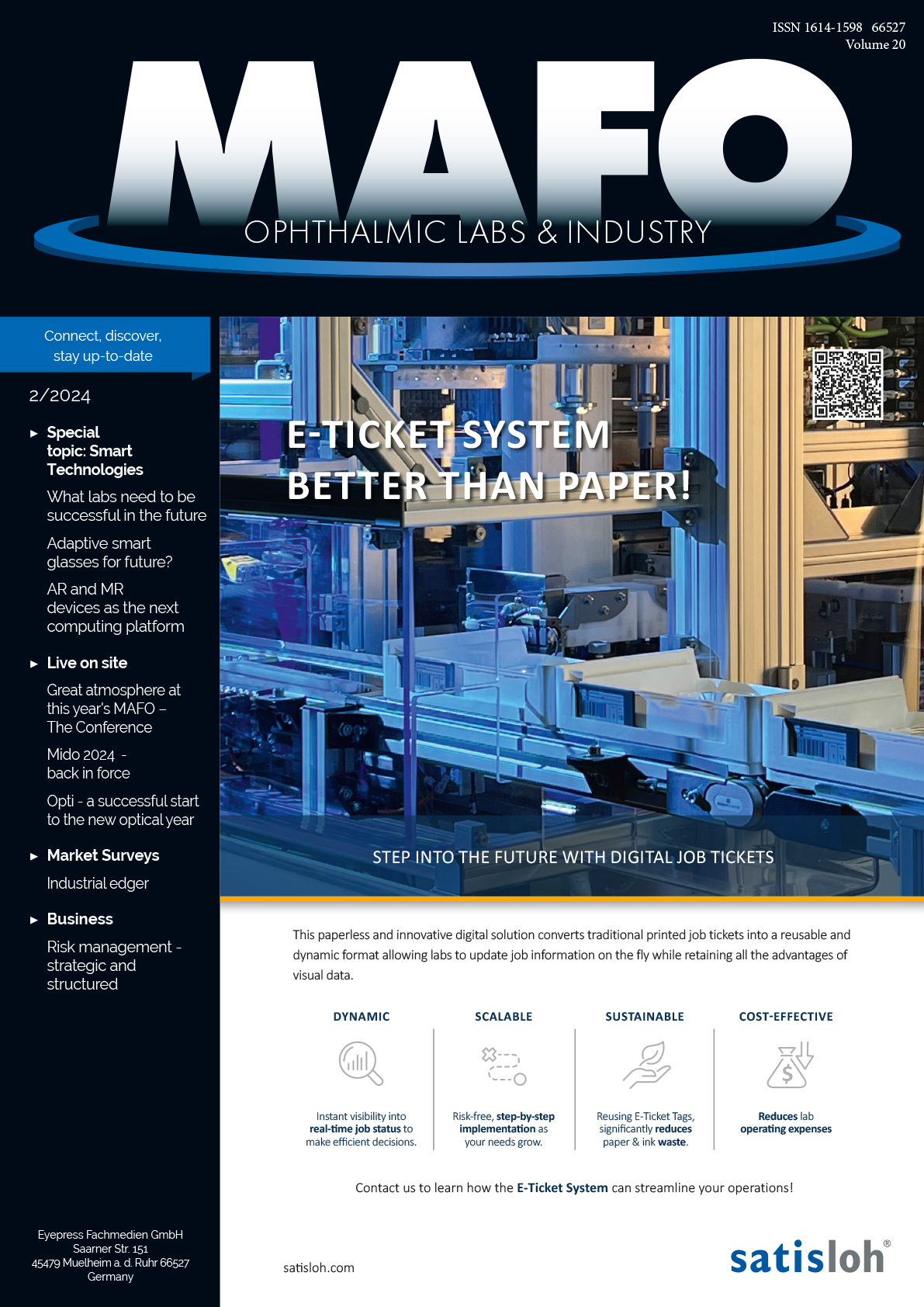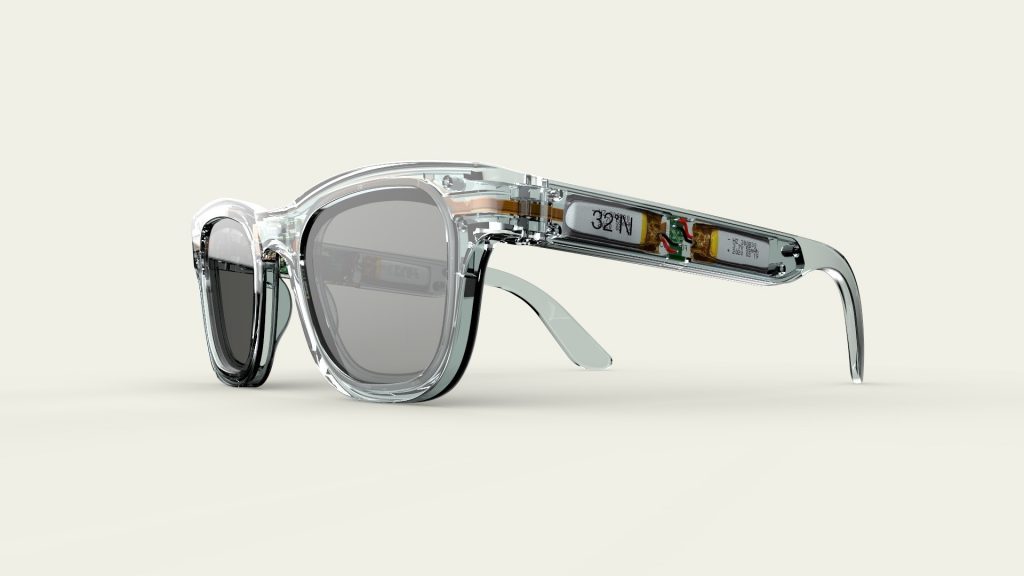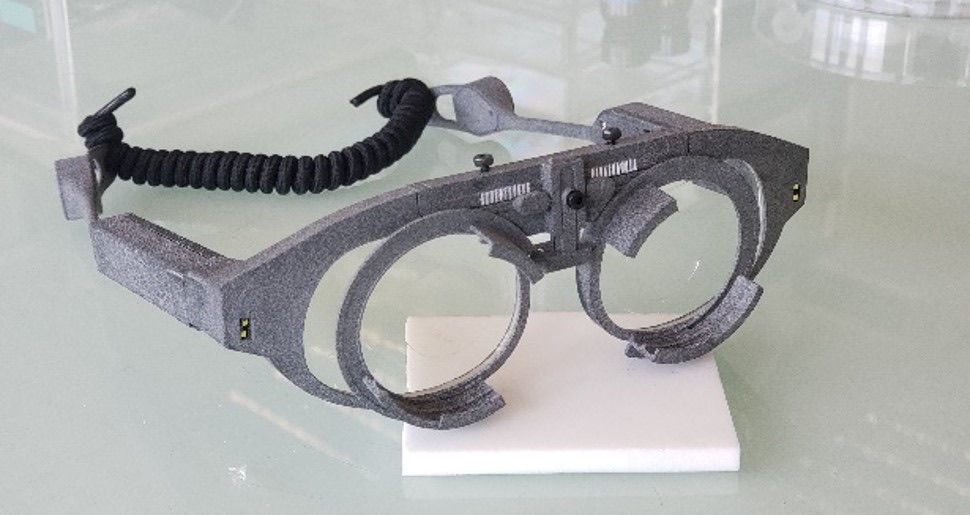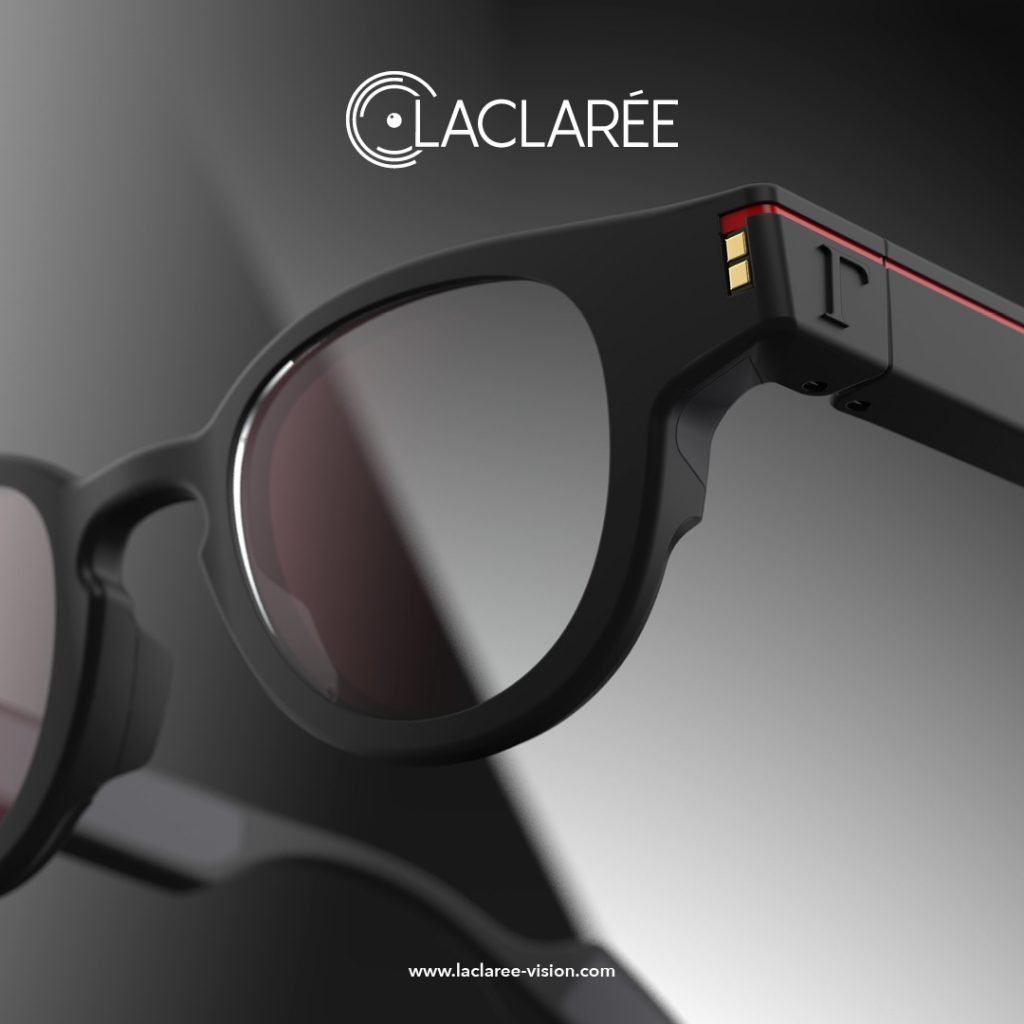Adaptive smart glasses for future?

The innovation of liquid crystal technologies in spectacle lenses
When your arm gets longer and longer after the age of 40 and the words in the newspaper seem to get smaller with every issue, it is time to take a look at the natural ageing process of the eye. With advancing age, changes in vision occur, particularly in the near vision range. Presbyopia affects everyone at some point and experts believe that more than one billion people worldwide have presbyopia and that the number will continue to rise in the future. Ground-breaking progress has been made in recent years, particularly in the field of spectacle lenses with liquid crystal lenses. The term smart glasses can be used for adaptive optics as well as for microcomputers integrated into spectacle frames, which can be used to communicate, take pictures or even navigate. This article, gives a brief insight into the developments of adaptive optics, the corresponding structure of liquid crystal lenses and the resulting benefits in practice.
Presbyopia
But first the basics ‒ what is presbyopia? Presbyopia is a progressive loss of near vision. It is caused by the lens of the eye, which is part of the optical apparatus. Usually, the lens can change its curvature and its refractive power due to its own elasticity, so that objects can be recognized sharply both at a distance and close up.
Over the years, however, the natural ageing process of the eyes continues. In this context, the flexibility of the lens is reduced, and it becomes more rigid, which in turn leads to a reduced ability to accommodate. Once this happens, a visual aid is required. However, there are various types.
Options of visual aids
Contact lenses are one option for correction. In addition to single vision and multifocal variants, these are also available as monovision so that objects can be recognized both close-up and in the intermediate range as well as at a distance. According to the latest findings, an alternative option is orthokeratology lenses, which can create a multifocal effect of the cornea when worn at night.
Another group is (refractive) surgery, which includes intraocular lenses, intracorneal rings or laser surgery. The disadvantage is that precise centering is necessary during the operation, as the changes to the cornea are irreversible.
With the aim of reducing the disadvantages of previous correction options, research is currently being carried out into drug therapy for presbyopia using various eye drops.
But by far the best-known correction option for presbyopia are reading glasses, which are available on the market in single vision, multifocal and progressive versions. The disadvantages of these spectacles are reduced visual acuity in the intermediate and very near ranges. In addition, very precise centering of the spectacles in relation to the optical axis of the eye is necessary. Progressive lenses in particular can lead to a severe limitation of the field of vision, while this can occur with reading glasses due to the spectacle frame.
In this context, various companies are researching the development of liquid crystal lenses in order to minimize or eliminate the disadvantages through innovative lens designs. At least two companies already have such glasses on the market and others are working on them.
History of liquid crystal lenses
The liquid crystal was first described in 1888 by the Austrian botanist Friedrich Reinitzer. He observed that cholesterol benzonate melted at a heat of 145.5 °C (≈ 294 °F), but in a cloudy composition. If the temperature was increased by 30°C (≈ 86 °F), its appearance changed abruptly to a clear melt. He thus recognized that the cholesterol benzonate molecules in the cloudy phase had a certain arrangement that was responsible for the light-scattering properties.
100 years later, C. W. Fowler and E. S. Pateras reported on the use of liquid crystals in spectacle lenses to change the refractive power of the corrective lens. Liquid crystals have undergone remarkable development, particularly in recent years, for example in the (smartphone) camera and spectacle glass industries.
In the early 2000s, a team led by American scientist Tom Krupenkin developed one of the first liquid lenses. Internationally, these are known as liquid crystal lenses (LCL). Liquid crystals represent the mesophase of a material in which the properties of both liquids and solids (crystals) are at work. For this reason, the state of order of these substances is often referred to as a fourth state of aggregation.
Beginning in 2009, the company PixelOptics became well-known in the industry as many trade journals reported on it. In 2011 the company launched the product emPower! ‒ the first electronic focusing prescription eyewear. The patented technology was developed by PixelOptics and Panasonic Healthcare. However, the company filed for bankruptcy in 2013 and the patents were later bought up by Mitsui Chemicals [1].
In February 2024 Zeiss Vision Care announced the successful acquisition of a comprehensive intellectual property (IP) portfolio, including a suite of patents, from Mitsui Chemicals. This strategic move should solidify Zeiss commitment to advancing technology in the eyeglass lens industry and further opens new opportunities for the development of electro-active lenses and spectacle frames. In 2022 Zeiss Ventures has invested already in Morrow, a high-tech start-up from Belgium developing autofocal glasses (find out more about Morrow on the following sections).
Adaptive lenses today
Research to date has laid the foundation for today’s goal of fast, uncomplicated and customized adaptation of visual acuity to environmental conditions without the occurrence of aberrations or the need to change glasses.
Adaptive lenses are spectacle lenses that can change their focal length under the influence of an external stimulus such as a magnetic field, thermal effect or electrical voltage. The functional principle of liquid crystal lenses can be roughly divided into two different principles – the two-phase lens and the single-phase lens. What both variations have in common is that there is liquid in the center of the lenses.
Two-phase (lyotropic) liquid crystals
The first principle is based on two-phase (lyotropic) liquid crystals. Two immiscible liquid media, such as oil and water, are placed in a chamber. The liquids should have the same density, but different refractive indices and reactions to electrical impulses.
The chamber can be created by a cavity within a spectacle lens. At rest, the two media are balanced next to each other. When an external stimulus (e.g. electrical voltage) is applied to the surface of the chamber, the electrical field within the chamber is modified. This changes the contact angle between the two media and the orientation of the liquid crystal molecules.
This results in a change in the curvature of both media in the chamber, which in turn leads to a change in the focal length of the lens. This method can be modified by a deformable membrane so that liquids that are miscible can be used.
Single-phase (thermotropic) liquid lenses
The opposite principle involves single-phase (thermotropic) liquid lenses. The structure of these lenses is based on liquid crystals, which are enclosed in a thin layer between two transparent electrodes.
By applying an electrical voltage, the molecules can be aligned in a defined manner, thereby changing the refractive properties and thus also the focal length of the lens.
eProgressives by Morrow Eyewear
The Belgian company Morrow Eyewear describes its liquid crystal lenses as “eProgressives”. This development won the 2023 Silmo d’Or award in the field of vision. In 2023, the Silmo d’Or honored creative and innovative developments by companies in ten different categories with two additional jury prizes for the 30th time. The categories deal with lens designs, frame designs adapted for children or sporting activities and examination devices for measuring the eyes.
The Belgian manufacturer’s lens design is described as “proprietary lens-in-foil technology”. The lens consists of electrically variable liquid crystals, which in turn are based on Fresnel lenses. The refractive power of the polarization independent lens is changed by applying a low power electric filed.
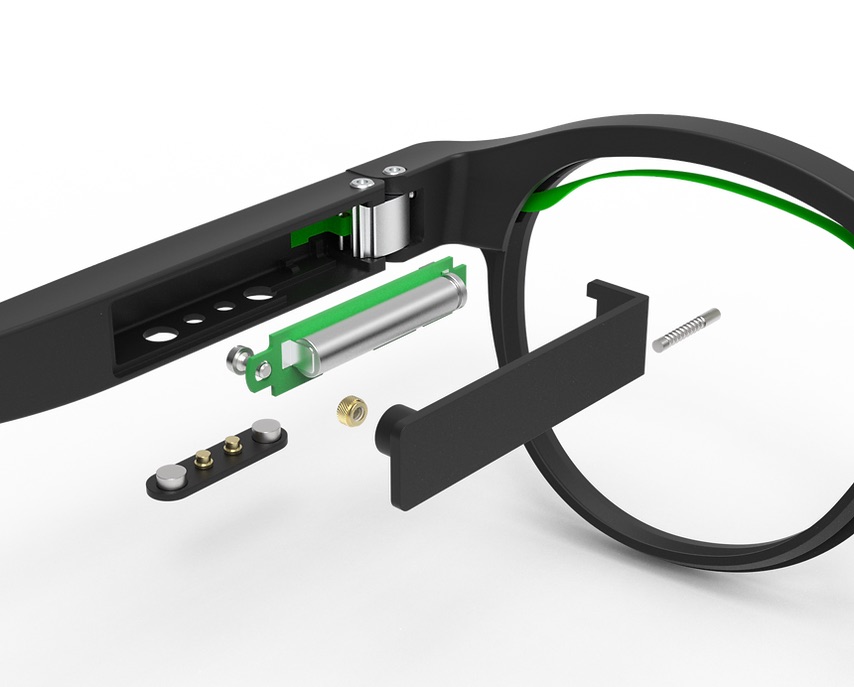
The eProgressives should be seen as an alternative to multifocal optics, which impair their wearers due to insufficient visual ranges. Morrow’s development was supported by imec, a Belgian research center for nano- and microelectronics, and the Belgian-Japanese lens manufacturer Tokai Optecs.
With the glasses’ press-bottom control, a brief touch on the temple changes the focus setting of the lenses. Using the liquid crystal-based lens an optical boost of 1.0 diopter is added to the passive progressive and meets the final prescription of the user.
The lenses have an anti-reflective coating and a hard coating. They also feature a CE certification and an IP68 water protection rating. IP68 certification means that the device is both dust- and waterproof. In this context, waterproof means protection against continuous immersion in water up to a maximum depth of 1.5 meters for a maximum of 30 minutes. However, the company primarily emphasizes resistance to rain.
The lens technology is divided into two setting options. In the OFF state, a clear field of vision is provided in the distance and intermediate zones. This provides additional comfort for everyday activities such as driving and shopping. So far, so familiar.
Improved vision in the intermediate range is a result of the elimination of the restricted focal channel in conventional progressive lenses or the lack of sharp transitions between focal planes in bifocal lens designs. In this context, objects can be recognized in the intermediate area in the lower part of the lens – but almost across the entire width of the lens.
Another advantage of these lenses is the improved depth perception. The well-known multifocal effect should be reduced by the lenses, as there are no demarcated areas of vision. In this context, there is also no need to search for the correct head position to recognize writing at the desired distance.
Moreover, reduced peripheral distortion of the special lens design is a great benefit compared to regular progressive lenses. This means that sharper images can also be achieved in the peripheral areas of the lens, resulting in a larger field of vision.
The ON state of the eProgressive lenses changes the focal point of the lenses from distance to near – within 0.6 seconds. The wide reading range of around 24 mm and the associated limitation of the aberration zone results in a high level of reading comfort and a lower risk of aberrations occurring. As a result, the eyes and the brain have to process fewer different image impressions, which in turn reduces susceptibility to dizziness.
Furthermore, both the contrast and the precision of the lenses are increased by reducing aberrations. The area of the lens design for near vision extends to the center of the prescription lens. In the upper area, objects in the distance or in the intermediate range can still be recognized at the same time.
The effective range of the lenses is between -6.0 and +4.0 diopters with a maximum addition of +4.0 diopters. Astigmatism is also corrected in the prescription lens.
The average autonomy of the glasses is around two days, depending on the use of the different modes. In continuous OFF mode, the glasses’ battery lasts for up to two weeks; in continuous ON mode, it only lasts for eight hours. The battery is fully recharged within 30 minutes. But what happens if the battery is completely empty and no charging option is available? Then the system automatically goes into fail-safe mode, while the glasses are fully functional in OFF mode, according to the manufacturer, as the optical boost is deactivated.
32°N by DeepOptics
A further development of liquid crystal lenses can be traced back to the Israeli start-up DeepOptics, which launched the 32°N liquid crystal sunglasses with variable focus on the market in 2021 in cooperation with Fielmann. In this context, the investment company Fielmann Ventures has acquired a 10 per cent stake in the start-up.
Deep Optics CEO Yariv Haddad emphasises the “advantages of the joint development of the glasses”, as his company’s employees contribute in-depth technological know-how and product development expertise, while Fielmann contributes its far-reaching understanding of customer needs with ophthalmic expertise.
The first innovation from the collaboration is a pair of sunglasses that can be converted into reading glasses at the touch of a button on the temple. The 32°N glasses achieve dynamic focus via pixelated liquid crystal lenses. Millions of pixels form the so-called liquid crystal layer. The orientation of the crystals in the layer can be varied, depending on the distance at which a sharp image is to be generated.
However, this alignment does not happen by itself, but by applying a voltage. The voltage in turn is triggered by the wipe change or pressing a button on the temple. This results in either a diffusing or focusing effect with regard to the optical power of the lenses. Based on the setting variants, a distinction can be made between “scene mode”, which was developed for seeing at a distance, and “reading mode” for close-up work, such as reading a menu.
As shown in figure 3 the liquid crystals for scene mode (distance) are all parallel to each other, without any tilting of the individual lenses. The more the crystals are tilted in this case, the more the incident light is refracted, so that the focal point moves closer to the lens. This shows that the setting for reading mode includes both parallel lenses and lenses rotated by 90 degrees.
The inter-pupillary distance (IPD) is also measured for these glasses to ensure an exact fit. The closer the object to the eyes, the lower the IPD. In addition, the distance between the centers of the active lenses is also checked.

According to the manufacturer, the magnification range of the lens can be individually varied between 0 and 2.5x. The lenses also have an anti-scratch coating, UV protection and polarization filters. The total weight of the sunglasses is said to be around 45 grams.
The aim of the start-up is to adjust the dioptric effect and control the glasses via an app that can be operated using a mobile phone. This should be available in both the Google Play Store and the App Store.
The plan so far is to offer a paid subscription in the app.
The innovation was first presented at the Consumer Electronics Show (CES) in Las Vegas in 2022. In the same year, this development received the “Best Innovation in Style” award from “Time Magazine”. On the official website of the Israeli company, the glasses are available in the colors black, caramel, brown and a transparent version, in which the technology behind the glasses can be seen, for around 849 dollars.
32°N glasses are currently only available in the US. The glasses will be showcased at Vision Expo East in New York.
Laclarée
The third company in this group is the French start-up Laclarée, launched in 2016 by founder Bruno Berge, who started the technological development of adaptive lenses. Laclarée develops autofocus eyeglasses. Presbyopic people will be able to retrieve a fluid, natural and always acute vision. This project combines knowledge and experience from the fields of physics, materials technology, optics (vision science) and business administration. The first prototype was created after just two years of research.
Based on this, 2019 the company received a seed funding in the total amount of 2 million euros to continue development. Two of the most active seed capital investors, Kreaxi from France and High-Tech Gründerfonds (HTGF) from Germany, are involved in this funding.
The first trials of the development were carried out on around 40 presbyopic subjects with the CHU St-Etienne (Dr Trone, Pr Gain, Dr Thuret, France) to check the relevance of the design. According to the company, the feedback was very good. Ophthalmic retailers, ophthalmologists and experts from the optical industry also had the opportunity to test the lenses for functionality. Once again, all those involved agreed that the lenses should be used. But how do these spectacle lenses work?
On the one side, they differ from the designs from Israel. The lenses from the French start-up consist of four different layers. The two outer, clear layers represent a regular unifocal lens design. These contain the dioptric correction values and have additional layers, such as a hard layer.
The two middle layers form a central doublet lens, which has a diameter of around 20 millimeters. These layers in turn comprise two liquids with different refractive indices. Both are separated from each other by a deformable membrane. The introduction of additional liquid leads to a change in the curvature of the lenses, allowing the focal length of the lenses to be varied. The higher the volume in the high-index layer, the more positive the effect (Jarosz et al., 2019).
The liquids of both layers can be pumped into or out of the center of the lens via two microfluidic actuators with a low power of a few mW. In addition to the opto-fluidic actuator, the glasses are completed by 2 ToF laser sensors on each side of the eyeglass pair. These sensors are evaluating the distance to the object being viewed. The result is then used to derive the required volume of the two liquids inside the lens.
The prototype takes around 1 second to change focus between the different distances. According to the company, all components of the glasses are compatible with a wide range of spectacle frames, meaning that the glasses can be customized to the wearer’s individual needs. A detailed description of the lens prototypes can be found in the publication by Jarosz et al. from 2019 [2].
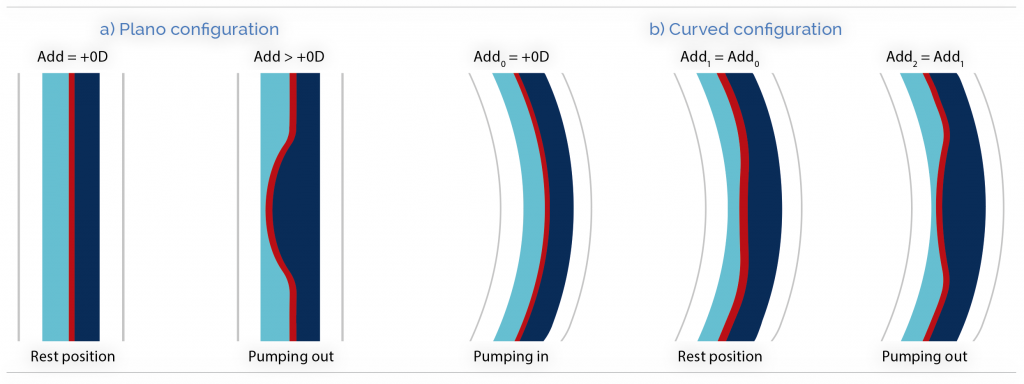
The product should be launched on the market by the end of 2025, at small scale with the seed funding. However, the company is still working on raising funds to accelerate the scale-up, with the goal of supplying to optical retailers in industrial quantities. The latest release of the company is a trial-frame for opticians. Their customers will be able to test the vision comfort provided by the autofocus lenses, and then sell the pairs. The final product will get commercialized in 2025.
There are currently several further companies researching and developing liquid crystal lens technology. The topic is also expanding to include intraocular- and contact lenses [3]. Whether certain existing designs will prevail or completely new developments will dominate the market remains to be seen in the future. So far, there is great potential around the topic presbyopia, paving the way for a wide range of innovations. ◆
References:
[1] https://www.visionmonday.com/latest-news/article/newly-formed-mitsui-subsidiary-to-revive-pixeloptics-electronic-eyewear-1, current from 14.02.2024
[2] Jarosz J, Molliex N, Chenon G, Berge B. Adaptive Eyeglasses for Presbyopia Correction: An Original Variable-Focus Technology. Opt Express 2019;27:10533-52.
[3] Syed IM, Kaur S, Milton HE, et al. Novel Switching Mode in a Vertically Aligned Liquid Crystal Contact Lens. Opt Express 2015;23:9911-6.

Lena Petzold
Lena Petzold began her bachelor’s degree in optometry at the Ernst Abbe University of Applied Sciences in Jena, graduating in October 2021 and immediately continuing with her master’s degree. In 2024, she also completed her second degree: the Master of Science in Optometry, Ophthalmotechnology & Vision Science.
In 2022, she had the opportunity to present her bachelor thesis at the American Academy of Optometry. On the side, she has also been working at JenVis Research since 2021.


